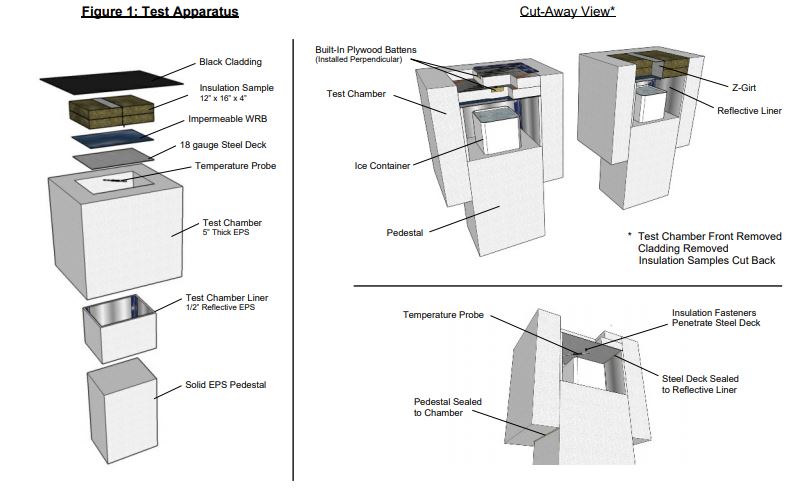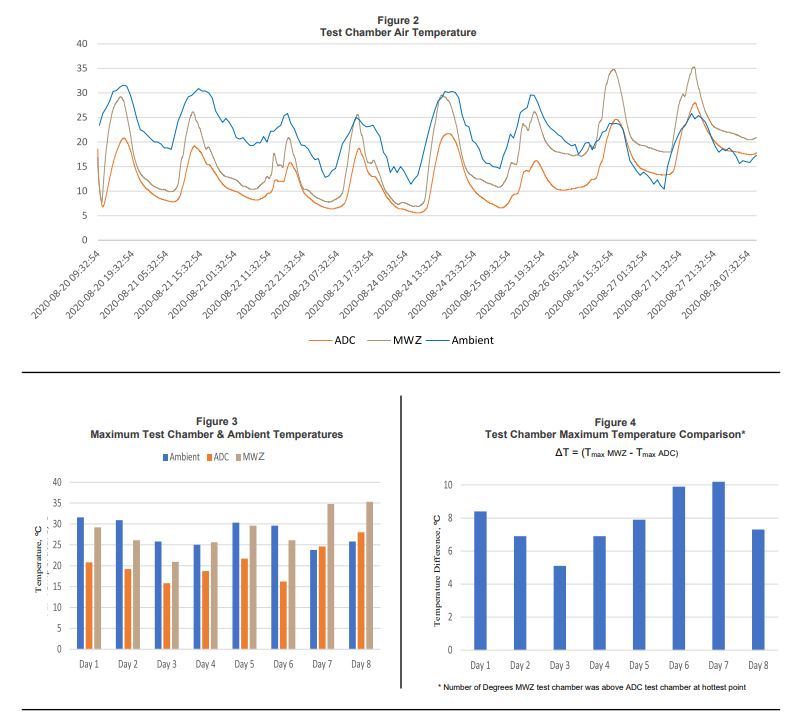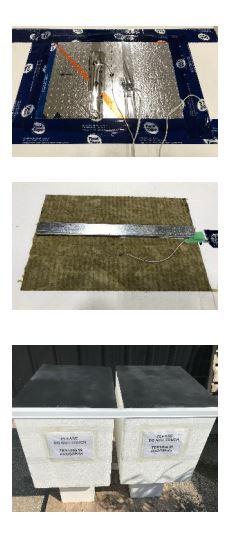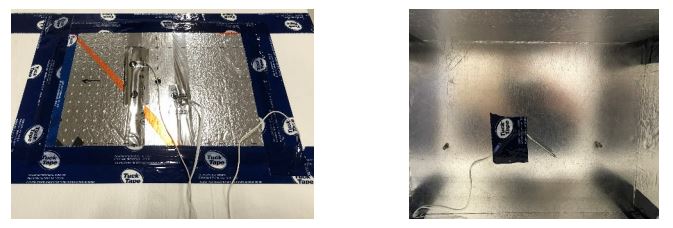The following test method relies on simple physics to illustrate how two completely different insulation systems – rigid Mineral Wool (MW) with a continuous steel girt (MWZ) and Vented & Perforated EPS Air Dry Connect (ADC) perform/insulate, comparatively during a hot summer week in Winnipeg.
Test Description and Apparatus:
The test methodology focuses on the 2nd Law of Thermodynamics – in particular; heat migrates to cold. The test is simple, intuitive and repeatable. Identical ice blocks (by weight) become low-tech air-conditioners. Ice melts as it warms. The faster it warms, the faster it melts. The ambient outdoor environment changes in real time.
Insulation Assemblies:
- 12” x 16”. 2” thickness x 2 layers – nominal R-16.8. For both assemblies there is a 2 mm air space between the bottom of the metal cladding and top of the insulation systems.
- The Vented & Perforated Air Dry Connect (ADC) incorporates built-in 3/4” thick x 2.5” wide plywood framing. Low emissivity (reflective) perforated polymer films are laminated to both sides of Type 2 EPS. There is a nominal 2 millimeter air gap between the peel and stick impermeable WRB and bottom layer of ADC, and between the bottom and top ADC layers. Through
 the 3/4” plywood framing, two evenly spaced fasteners connect the bottom layer to the WRB and 18 gauge steel deck. One fastener connects the top plywood framing to the bottom layer framing. Black metal cladding lays on top and is in direct contact with the top ADC fastener.
the 3/4” plywood framing, two evenly spaced fasteners connect the bottom layer to the WRB and 18 gauge steel deck. One fastener connects the top plywood framing to the bottom layer framing. Black metal cladding lays on top and is in direct contact with the top ADC fastener. - The Mineral Wool (MW) is recommended for exterior insulated assemblies. Two fasteners connect a 4” steel Z girt to the WRB and steel deck. The MW samples friction fit snuggly between the steel girt and the insulated test box surround. Black metal cladding lays on top of the MWZ assembly and is in direct contact with the Z girts.
Test Apparatus (Figure 1):
- Two identical 5” thick Type 3 EPS boxes are lined on the inside with 1/2” Type 3 reflective polymer faced EPS. Combined Nominal R-value: R-25. The bottom EPS pedestal within the test box equates to R-38
- The R-16.8 insulation assemblies are meticulously fitted into the top opening of the test boxes. ADC panels are taped to the top of the box – as they would be in the field. As per best practice, MWZ panels friction fit snuggly into the test box opening. The underside perimeter edges of the 18 gauge steel substrates are spray foamed to the 1/2” interior liner panels. Other than what occurs at fastener penetrations, air leakage is effectively eliminated.

- Identical 6.3 kg (14 lb.) frozen ice block’s (in plastic bladders) sit on top of the EPS pedestals. The ice blocks do not touch the interior sides of the ice chamber. At close tolerances, the test boxes slide over the pedestals. The pedestals butt tightly against the bottom interior liner edges. The bottom of the test boxes are spray foam sealed to the pedestals.
- Temperature data logger probes are taped to the bottom side of the steel substrate. The probes hang freely. They don’t touch the ice blocks. The data loggers record the air temperature of the test box chambers and humidity within the insulation samples. As the ice melts, stand alone thermometer probes located under the ice blocks indicate the diminishing temperature of the ice as the ice phase changes to water.

Data Collection (Temperature and Moisture Readings):
- For both assemblies, every three minutes a data logger recorded the air temperature of the test (ice box) chambers.
- Hourly historical weather data was obtained for the test location (Winnipeg). In addition to the local area weather data, the highest and lowest temperatures were recorded daily.
- Stand alone thermometers measured the diminishing temperature of the ice blocks.
- Random top surface moisture meter readings were taken on day 7. Because we didn’t want to disrupt the insulation samples during the testing procedure, we chose not to take internal moisture readings.

Summary of Results

Observations & Conclusions:
- During hot periods, IR imaging for the black metal cladding indicated surface temperatures of 80°C.
- Both ice box chambers warmed when the outside ambient temperature increased. Conversely, both chambers cooled when the outside temperature decreased (Figure 2).
- Throughout the test period, the ADC ice chamber temperature remained colder than the MWZ chamber temperature. The temperature differential widened significantly over the last several days (Figure 3).
- During hot periods, the ADC ice chamber was significantly colder than the MWZ ice chamber – often by as much as 10 degrees (Figure 4).
- Morning of the 7th day of testing. Using a moisture meter (not known for pin point accuracy), the top of the MWZ sample indicated moisture content averaging 8.5%. The ADC sample averaged 5% moisture. We did not moisture test the bottom insulation layers.
- The MWZ ice melted faster than the ADC ice. The MWZ melting process accelerated over the last four days.
- After the ice blocks melted and had effectively lost they’re ability to cool, the ADC ice chamber remained significantly cooler than the MWZ Chamber (Figure 4).
- Upon completion of the testing, both assemblies were dissected. For either assembly, there was no indication of expansion, contraction or material degradation
Note from the Author:
Do your own testing. You can make your own test boxes. Depending upon the testing ambient environment, your results will vary somewhat from these results. However, assuming the test box assembly is effectively air tight, the trends from your testing will align with ours. Learn more at quiktherm.com
About the Author:
Ted Cullen is President at Quik-Therm Insulation Solutions. Over the past 10 years, he has designed and developed several multi-functional innovative insulation technologies. Cullen has applied for and been granted 3 utility patents. 2 other insulation technologies are currently in the “patent pending” stage. One proprietary invention; a unique pressurized propulsion technology has been successfully manufactured and marketed for over two decades. Ted can be reached at ted@quiktherm.com
Previous Studies:
Steven Doggett, PhD, LEED AP: https://www.dropbox.com/s/9fn61kvsl03q5p6/ Doggett%20Review%20Physics%20Testing.pdf?dl=0
Quik-Therm Insulation Solutions: https://quiktherm.com/how-insulation-works/
Thermal Bridge Free Insulation System
 the 3/4” plywood framing, two evenly spaced fasteners connect the bottom layer to the WRB and 18 gauge steel deck. One fastener connects the top plywood framing to the bottom layer framing. Black metal cladding lays on top and is in direct contact with the top ADC fastener.
the 3/4” plywood framing, two evenly spaced fasteners connect the bottom layer to the WRB and 18 gauge steel deck. One fastener connects the top plywood framing to the bottom layer framing. Black metal cladding lays on top and is in direct contact with the top ADC fastener.

